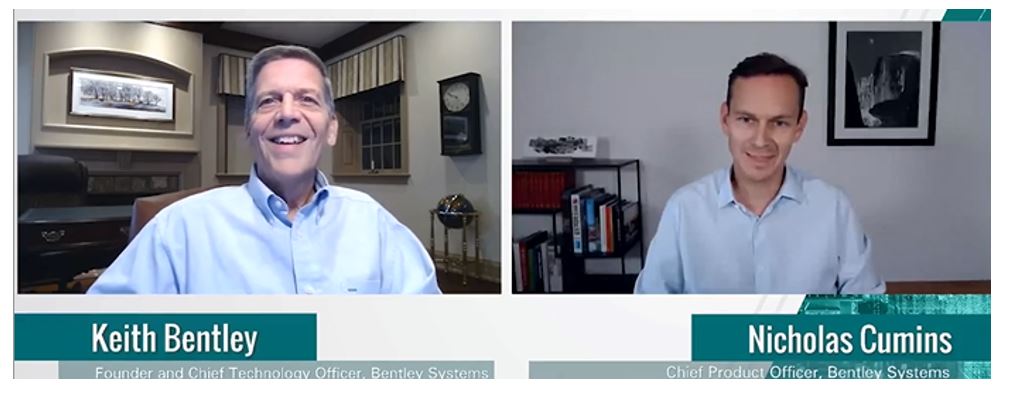

For the first time ever, Bentley Systems Year in Infrastructure 2020 Conference (YII) went digital! The virtual format was interactive, informative, and saw the convergence of a global audience represented by over 130 countries. Besides hearing about the Digital Twins Executive Perspective, the highlights included:
In his welcome address, Greg Bentley, CEO of Bentley Systems, spoke about the advancements in infrastructure engineering software and cloud services, and how it empowers professionals to design, build, and operate infrastructure that is economically and environmentally sustainable. He said that this has been a transition year - Bentley Systems began as a privately held company for 36 years and is now publicly held (following the company’s IPO on September 22—NASDAQ: BSY).
Digital twins were at the front and center stage of the dialog between Keith Bentley, Founder and CTO and Nicholas Cumins, Chief Product Officer of Bentley Systems. This blog captures the key points discussed. The video of this Executive Perspective session is available here.

The concept of digital twins is not new and has been around for many years. Now, the ISO is creating a committee to define a standard for digital twins, which means that the concept has really hit mainstream. A basic definition of digital twins in the infrastructure space is “synchronized virtual representation of the physical asset.” Elaborating on this, Keith Bentley said that it is an electronic virtual representation of the physical world, which would have enough information to understand not only how something is and how it looks, but how it works (functional capabilities). If digital twins are going to be used for business and operational decisions it has to accurately reflect what is happening in the real world.
A trustworthy virtual representation of what exists in the real world could be used to make quick decisions when emergencies arise or plan for probable eventualities, etc. Assets are operated on a daily basis and decisions are made based on obsolete data or human intuition. So, the digital model can be used to help understand what’s going on in the real world/physical asset and accordingly make changes. In the future, many additional problems could be solved by using the models in the digital plan.
Bentley has been building the required technology for digital twins. Experience has taught them that reliability and quality of data are very important. A few years ago, discussions centered on the glut of information being created in different processes and how to repurpose it for the digital twin concept. What Bentley learned is that data is really valuable only when structured properly and in a reliable form; after that it must be synchronized across the different versions available worldwide.
Users have found immense value in transitioning from old business processes to a digital twin process. There’s no need to scrap the old and start afresh; you can gradually add to the existing processes/equipment. It’s a learning process as the user realizes that there are better ways to do things, and the software to support this has grown substantially. With technologies, such as ContextCapture and reality modelling, you can send a drone to take pictures and create a digital twin. “To get some value out of a digital twin, you don’t really have to change much,” said Keith Bentley. “You can start at any stage in the lifecycle,” added Nicholas Cumins.
Digital twins must be built around open and extensible software terms. Bentley has built a digital twin platform iTwin (software to model, represent, visualize, and interpret the contents of a digital twin) that is open source. So, the user is no longer dependent on a single vendor and can use a wide ecosystem of players that can be integrated through open concepts. Digital twin data in assets is diverse and large, involving lots of disciplines and companies, and these have to be synchronized. The ecosystem of people who can innovate with the digital twin and work outside the purview of Bentley Systems are a value add.
Digital twins will be more widespread simply because they provide data accessibility. Instead of writing algorithm software, the next frontier is to study patterns in the data and innovate around machine learning and augmented reality. The limiting factor as to why it hasn’t happened today is that the data is unavailable. The digital twin can provide the input to the machine and revolutionize the concept of designing, operating, building, and maintaining large-scale assets.
2020 has taught the world that the future can’t be predicted. Digital representation of things is becoming the norm, and everyone is looking for better ways of doing things. It is the beginning of the digital revolution in business processes and across industries.

